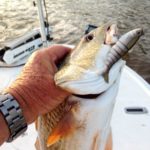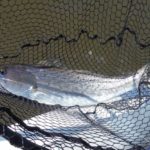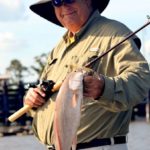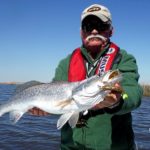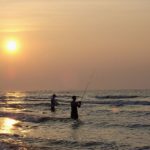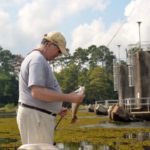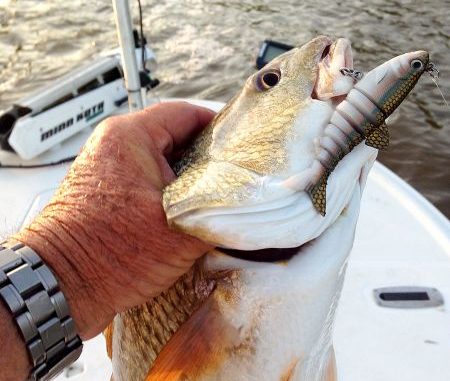
Trout and redfish don’t disappear from the Calcasieu system when the heat of summer blasts the area. Here are some tips on how to continue catching plenty of fish.
While many Calcasieu Lake anglers were bemoaning the lack of fishing success last August, Moss Bluff’s Ray Christy was enjoying great action.
The 67-year-old angler and retired guide was busy motoring around the north, south and central portions of the Calcasieu estuary, where he could be found catching plenty speckled trout and redfish.
And among his best trips last summer was one that occurred on the beachfront just south of the lake.
“I got down there early and headed out to 2 miles east of the jetties,” Christy said. “The waters were almost emerald green, and I stopped when I saw birds on the beach.”
Once the angler engaged his Power-Pole, he began a series of casts with an old bone-colored Ghost, a topwater lure that is no longer available to anglers.
“I was working it right at daylight, making long casts down the guts of the beach,” Christy said.
As the angler dog-walked the lure, he was rewarded with blowup after blowup. The trout were aggressive and numerous, and this action continued for an hour.
When the topwater bite played down, Christy changed over to spinning equipment with braided line and began casting Egret Baits’ gold nugget- and creole magic-colored Wedgetail Mullets.
“Those baits are really good because you can feel the tail fluttering and the solid thump on the braid when the trout hit them,” he said.
The angler caught more than just a few trout on these baits as the morning continued to wane.
Later on, the angler saw finger mullet in a certain location, so he reached in his storage box for a cast net. After catching a number of these live mullet, Christy began casting the baitfish out on a Carolina rig.
“The trout just smacked the heck out of the mullet,” Christy said.
It was all over before noon, and the angler had caught and released over 60 speckled trout ranging from 2 to 6 pounds.
“That was the best trip I had on the beach last August,” he said.
In the heat of August, anglers can be seen fishing with live shrimp and plastics under popping corks where birds are working early in the morning.
As the day grows longer and the bird activity disappears, anglers usually turn to deeper water and cast plastics, or they try live baitfish such as pogies, menhaden or finger mullet on Carolina rigs.
But Christy fishes to the beat of his own drum.
His many years of experience as a guide on Calcasieu Lake has paid off, and he is known to score even when fishing has been its toughest on the lake.
And there are three areas in which he caught a lot of specks and redfish throughout most of August and September: the saltwater barrier to the north, south-central lake areas and the Ship Channel, and the beaches south of the lake.
Here are his approaches to fishing each of these summertime hotspots.
Saltwater Barrier
The Calcasieu River saltwater barrier is located just north of Westlake and Lake Charles. It’s purpose when authorized in 1962 by Congress was to block saltwater intrusion farther north in the Calcasieu River.
It also allows navigation to and from the Calcasieu River into the old river channel, Lake Charles and ultimately all the way to the Gulf through the Cameron jetties.
But it also has become a structural boon to local anglers, who catch a mixture of brackish-water species there to include speckled trout, redfish, flounder, stripers, hybrid stripers, black drum, freshwater drum and largemouth bass.
Occasionally jack crevalle and other species also can be taken in the vicinity of the saltwater barrier, as salinities can reach high levels during the summer months and early fall due to lack of rainfall in the Calcasieu River system.
Local access to the south (saltwater) side of the barrier is via a small public landing at Riverside Park located in Westlake at 1700 Miller Avenue.
Access to the north (freshwater side) can be acquired directly on the side of the barrier at the U.S. Army Corps of Engineers public landing at the end of Mims Road.
But Christy said there are some keys to catching fish at this local community hole.
“You have to watch the tides here to be successful,” he said. “When I fish it I want water coming over the top of the structures from the river side, since I often fish the saltwater side.
”I like a 6-inch drop coming over the weirs during a north wind.”
There are some really nice fish to be caught. Christy has taken numerous trout weighing 6- and 7-pounds.
And when conditions include loads of baitfish, redfish action can get hot. One of Christy’s trips one morning last August resulted in a combination of 40 redfish and stripers being caught and released.
Christy is one of those adaptable anglers who has transitioned to using large swimbaits for the trout and redfish just south of the structure.
“I have caught trout and redfish on big swimbaits like the 5-inch Wedgetail Mullet and Castaic’s Jerky Js,” Christy said. “I’ve also had recent success with Egret Baits’ new VuDu Mullets.”
When using jigheads on plastics like the Wedgetail Mullets, Christy begins with a ¼-ounce jighead to sweep the weir walls.
“I’ll use heavier jigheads up to an ounce until I start catching fish or until I get hung up on the rocks and structures,” he said. “If I am not successful fishing directly on the structure, I’ll back off 100 yards and start the process over again.”
Trout and redfish also can be found on the upriver side of the structure. However, bass can be taken, especially when shrimp and baitfish are flowing into the river from the saltwater side.
Smaller plastics such as white, 3 ¼-inch VuDu Shrimp and creole magic, 3 ½-inch Wedgetail Mullets will catch trout, redfish and bass. Topwaters such as Chug Bugs also will entice bass and speckled trout on the freshwater side, and small white/chartreuse spinnerbaits will also work well.
The good news here is that fishing success at the structure can be experienced well into the fall — as long as heavy rains do not push too much fresh water into the system.
Small boats can easily be used to fish both sides of the structure, as long as caution is heeded. Currents often cause strong flows into and out of the weirs, and a strong trolling motor is be needed to correct boat movement so as not to damage hulls and motors on the structure.
Southcentral lake area/Ship Channel
There are some very hallowed locations in Calcasieu Lake, including Long Point, the Old Steam Engine, Commissary Point and Basket Reef.
Christy enjoys fishing these areas, arriving at his choice each day before dawn.
Over the years, the angler has learned to actually sight-fish for large speckled trout when schools of large mullet roam these shallow flats.
“I have a small tower on my boat, and when I see these schools of roe mullet, I’ll often see speckled trout mixed in with them,” he said. “Sure, there’ll be 2- and 3-pounders, but I will also find and catch trout up to 8 pounds on topwaters.
“On one day, I caught six trout weighing 5 pounds and better, with one 9 ½-pounder in the group.”
That might surprise those who believe the heat pushes trout to deeper, cooler waters.
“There are always big trout in the lake,” Christy said. “And anglers who see these mullet schools and throw topwaters even in the middle of the day can catch them.”
As mentioned earlier Christy likes a bone Ghost, but he will also rip the Kick A Mullet Jr., making this suspending plug work right below the water’s surface.
Christy said the Old Tank Battery area continues to be a favorite location, and he fishes it about every day he’s out there in the late summer.
“There’s still shell down there,” he said. “I would say for sure to throw topwaters early, and then fish the reefs with plastics such as the Wedgetails and the new VuDu Mullet.
“You can also catch some school trout there with VuDu Shrimp under a popping cork under birds.”
For larger trout when birds are working, Christy works the area with plastics.
“Let the Wedgetails go down and you’ll catch better trout,” he said. “To do this effectively, you must throw past the school and let the Wedgetail go deep. Then slowly crank it in.”
When fishing this way under birds working over reefs, Christy uses a 1/8-ounce jighead so he can to work it back slowly above the reef without hanging up.
Access to these areas includes the public ferry landing, the landing near the jetties, Hebert’s Landing and Calcasieu Point Landing (Turner’s Bay).
As the day heats up even more, Christy will move over to locations along the Ship Channel.
“You are going to be fishing 10 to 12 feet deep here, and you definitely need some moving water,” he said. “You want to fish along the edges of the channel where there is scattered shell.”
Christy said likely places include the stretch of the channel across from the LNG Canal and on the channel edges across from Turner’s Bay.
Besides trout, these drop-offs will also hold fair concentrations of redfish and flounder.
“I’ll throw Wedgetails to the edges of the shell and let them sink into the deeper channel ledges, and catch trout and redfish,” Christy said. “I will also cast the big MirrOdine with the silver-green backs, as well as those with orange and purple.”
Christy lets these lures sink slowly and twitches them back to the boat.
Access to this portion of the Ship Channel include Spicer’s Landing in Hackberry, as well as Calcasieu Point Landing across the lake on its eastern side.
The beaches
The beach along Highway 82 holds quality trout for which the Big Lake system is known, and every year, anglers score numbers of these lunkers when conditions allow.
Although Christy scored his best trip east of the jetties, the beaches to the west — including Constance Beach and Mae’s Beach — offer great fishing for anglers in boats and those in the surf.
Optimal summer conditions include the rare northerly. But even when southeast winds pelt the area and muddy up the waters, the beaches can clear quickly after a couple of days if there’s not much rainfall.
Christy said baitfish will be pushed through cuts or low areas on the sandbars along the beaches, and trout will follow them into the troughs between the sandbars and beaches.
The way to fish these cuts is motoring or walking through the trough to the sandbar and cast east and west.
“You want your topwaters above (the cut) early in the morning, and plastics such as Wedgetail Mullets and VuDu Shrimp dropping in these cuts later,” he said.
The first trough can offer great fishing in the very early morning. Look for baitfish running in this trough and on the beach’s edge.
But Gulf fishing isn’t all about the beaches.
“South of the beaches, anglers can hit the short rigs located 6 miles out,” Christy said. “There are lots of trout at those short rigs, and anglers with larger boats will find them west of the jetties.”
